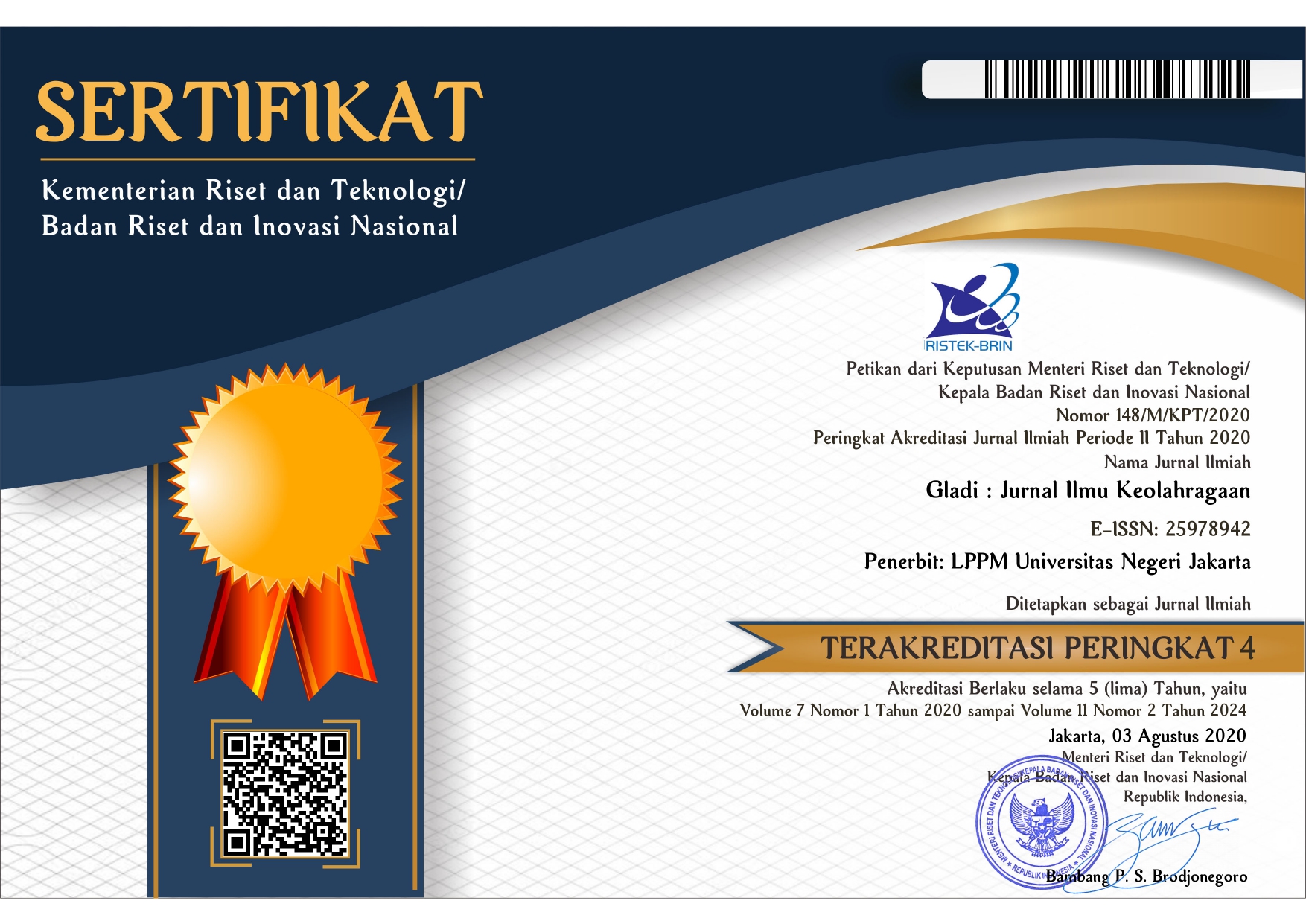DEVELOPMENT OF A CHANGE OF DIRECTION TRAINING MODEL FOR JUNIOR TENNIS ATHLETES
DOI:
https://doi.org/10.21009/GJIK.153.01Keywords:
change of direction, tennis, developing modelAbstract
This research aims to develop a Change of Direction (CoD) training model for junior tennis athletes. Developing a training model using the ADDIE approach (analysis, design, development, implementation, evaluation). In the fifth stage or evaluation, using a sample of 46, to determine the effectiveness of the CoD training model. The N-Gain Score test is used to determine the effectiveness of the CoD training model in junior tennis athletes. The research results showed that the average pretest was 17.66 sec, and after treatment (posttest) it was 17.02 sec. The results of the N-Gain Score test obtained an average value of 0.43, which means that the development of the CoD training model has moderate effectiveness in improving direction change skills in junior tennis athletes. Thus, the CoD training model developed can be applied to improve direction change skills in junior tennis athletes. Future research will need to determine the most effective form of training to improve athletes' change-of-direction skills, taking into account other factors that influence change-of-direction performance. So it can answer the challenge of how the CoD training method can significantly improve the ability to change direction and ultimately contribute to the performance of tennis athletes.
Downloads
References
Buhmann, R., Stuelcken, M., & Sayers, M. (2022). Alternatives to common approaches for training change of direction performance: a scoping review. BMC Sports Science, Medicine and Rehabilitation, 14(1). https://doi.org/10.1186/s13102-022-00544-9
Fernandez, J., Mendez-Villanueva, A., & Pluim, B. M. (2006a). Intensity of tennis match play. In British Journal of Sports Medicine (Vol. 40, Issue 5, pp. 387–391). https://doi.org/10.1136/bjsm.2005.023168
Fernandez, J., Mendez-Villanueva, A., & Pluim, B. M. (2006b). Intensity of tennis match play. In British Journal of Sports Medicine (Vol. 40, Issue 5, pp. 387–391). https://doi.org/10.1136/bjsm.2005.023168
Fernandez-Fernandez, J., Canós-Portalés, J., Martínez-Gallego, R., Corbi, F., & Baiget, E. (2023). Effects of different maturity status on change of direction performance of youth tennis players. Biology of Sport, 40(3), 867–876. https://doi.org/10.5114/biolsport.2023.121324
Fox, A. S. (2018). Change-of-Direction Biomechanics: Is What’s Best for Anterior Cruciate Ligament Injury Prevention Also Best for Performance? In Sports Medicine (Vol. 48, Issue 8, pp. 1799–1807). Springer International Publishing. https://doi.org/10.1007/s40279-018-0931-3
Hernández-Davo, J. L., Loturco, I., Pereira, L. A., Cesari, R., Pratdesaba, J., Madruga-Parera, M., Sanz-Rivas, D., & Fernández-Fernández, J. (2021). Relationship between sprint, change of direction, jump, and hexagon test performance in young tennis players. Journal of Sports Science and Medicine, 20(2), 197–203. https://doi.org/10.52082/jssm.2021.197
Horníková, H., & Zemková, E. (2021). Relationship between physical factors and change of direction speed in team sports. In Applied Sciences (Switzerland) (Vol. 11, Issue 2, pp. 1–18). MDPI AG. https://doi.org/10.3390/app11020655
Lloyd, R. S., Read, P., Oliver, J. L., Meyers, R. W., Nimphius, S., & Jeffreys, I. (2013). Considerations for the development of agility during childhood and adolescence. Strength and Conditioning Journal, 35(3), 2–11. https://doi.org/10.1519/SSC.0b013e31827ab08c
Martín-Moya, R., Silva, A. F., Clemente, F. M., & González-Fernández, F. T. (2023). Effects of combined plyometric, strength and running technique training program on change-of-direction and countermovement jump: A two-armed parallel study design on young soccer players. Gait and Posture, 105, 27–34. https://doi.org/10.1016/j.gaitpost.2023.06.025
Nagel, A., & Avram, C. (2013). Reference Values and Gender Differences of the Functional Parameters in Romanian Elite Junior Tennis Players. Timisoara Physical Education and Rehabilitation Journal, 5(10), 22–27. https://doi.org/10.2478/tperj-2013-0003
Pribadi, B. , A. (2014). Desain dan Pengembangan Program Pelatihan Berbasis Kompetensi. Pernada Media Grup.
Siener, M., Ferrauti, A., & Hohmann, A. (2021). Early talent identification in tennis: A retrospective study. Racket Sport Sci, 3(2). https://doi.org/10.30827/Early
Sinkovic, F., Foretic, N., & Novak, D. (2022). Reliability, Validity and Sensitivity of Newly Developed Tennis-Specific Reactive Agility Tests. Sustainability (Switzerland), 14(20). https://doi.org/10.3390/su142013321
Sukarelawa, M. I., Pd, M., Toni, K., Indratno, M., Pd, S., Suci, M., Ayu, S., & Km, M. P. H. (2024). N-Gain vs Stacking.
Tsutsui, T., Iizuka, S., Sakamaki, W., Maemichi, T., & Torii, S. (2022). Growth until Peak Height Velocity Occurs Rapidly in Early Maturing Adolescent Boys. Children, 9(10). https://doi.org/10.3390/children9101570
Volk, N. R., Vuong, J. L., & Ferrauti, A. (2023). Relevance of force-velocity and change of direction assessments for the ranking position in elite junior tennis players. Frontiers in Sports and Active Living, 5. https://doi.org/10.3389/fspor.2023.1140320
Wu, Q., Tan, Y., Sun, G., & Ding, Q. (2023). The relationship between self-concept clarity, athletic identity, athlete engagement and the mediating roles of quality of life and smartphone use in Chinese youth athletes. Heliyon, 9(10). https://doi.org/10.1016/j.heliyon.2023.e21197
Zemková, E., & Hamar, D. (2014). Agility performance in athletes of different sport specializations. Acta Gymnica, 44(3), 133–140. https://doi.org/10.5507/ag.2014.013
Zhang, Y. (2024). The optimization of college tennis training and teaching under deep learning. Heliyon, 10(4). https://doi.org/10.1016/j.heliyon.2024.e25954
Downloads
Published
How to Cite
Issue
Section
License
Copyright (c) 2024 Okki Yonda, Heru Miftakhudin, Nadya Dwi Oktafiranda, Ela Yuliana

This work is licensed under a Creative Commons Attribution-ShareAlike 4.0 International License.







